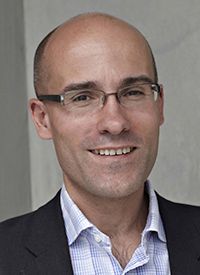Exposure to Environmental Carcinogens May Increase Risk for EGFR+ NSCLC
Increased exposure to particulate matter may be a mechanistic driver for EGFR-positive non–small cell lung cancer, prompting a focus on limiting exposure to air pollutants and an increased need for molecular testing.
Charles Swanton, FRS, FMedSci, FRCP

Increasing levels of air pollutant particulate matter observed in individuals with exposure to air pollution were associated with an increased risk for the development of EGFR-positive non–small cell lung cancer (NSCLC), according to findings presented at the 2022 ESMO Congress.
The findings build on the established association of atmospheric pollutants and lung cancer incidence, Charles Swanton, FRS, FMedSci, FRCP, said in a press briefing. “What we didn’t know until recently was whether air pollution directly causes lung cancer or if there was something more proximal in the pathways driving cancer. What this work shows is that air pollution is directly causing lung cancer, but through a slightly unexpected pathway,” said Swanton, a member of the Francis Crick Institute and chief clinician at Cancer Research UK in London.
Particles that are often found in vehicle exhaust and smoke from the combustion of fossil fuels may be associated with risk for NSCLC with EGFR mutations. The evidence presented here instigates the need to enact regulation of pollutant sources and increase molecularly targeted lung cancer prevention.
Investigators analyzed 463,679 individuals living in England, South Korea, and Taiwan to determine if increasing levels of particulate matter at 2.5 micrometer increment (PM2.5) concentrations were associated with cancer risk. Next, they performed ultra-deep profiling of 247 normal lung tissue samples from humans and mice following exposure to particulate matter. They then evaluated the consequences of particulate matter on tumor promotion in mouse models with lung cancer.
According to the abstract, increasing levels of PM2.5 were associated with an increased risk for EGFR-mutant positive NSCLC. In addition, they were also associated with an increased risk for mesothelioma (hazard ratio [HR] for each 1ug/m3 PM2.5 increment, 1.19); lung cancer (HR for each 1ug/m3 PM2.5 increment, 1.16); anal cancer (HR for each 1ug/m3 PM2.5 increment, 1.23); small intestine cancer (HR for each 1ug/m3 PM2.5 increment, 1.30); glioblastoma (HR for each 1ug/m3 PM2.5 increment, 1.19); lip, oral cavity, and pharynx cancer (HR for each 1ug/m3 PM2.5 increment, 1.15); and laryngeal carcinomas (HR for each 1ug/m3 PM2.5 increment, 1.26).
The investigators wrote that approximately 18% to 33% of normal lung tissue samples expressed EGFR and KRAS positivity, despite not testing positive for cancer.
During his presentation at the press conference, Swanton mentioned 2 models that have previously explained how carcinogens cause cancer: the Classical Mutation Model and the Tumor Promotion Model.
In the Classical Mutation Model, exposure to environmental carcinogens leads to DNA mutations, which result in driver genes that lead to tumor growth. “[For example,] that’s typified by tobacco, [or] carcinogens that generate C to A mutations in DNA and derive a classical mutation in [KRAS G12C],” Swanton explained, in turn emphasizing the innates problems with this model.
“First of all, we know that we are essentially a patchwork of mutant clones harboring cancer mutations in our normal skin,” he said. “…Cancer mutations may be necessary for cancer initiation, but they are not always sufficient to drive cancer. Added to this…[a 2020 study] showed that 17 out of 20 environmental carcinogens tested in mice do not induce DNA mutations.”
Despite these problems, the model could help to explain lung cancer in never smokers; however, such an explanation would need to fill 3 criteria to associate air pollution with the disease: explanation of geographic distribution of EGFR mutation–positive lung cancer, a proven causation, and an explanation as to how cancer can be initiated without directly causing DNA mutations.
In the Tumor Promotion Model, there are 2 steps to starting a tumor: the initiator event, or mutation, and the promoter event; however, Swanton noted that one would need both, not one or the other. In mice, it was found that preexisting potential driver mutations are caused by an endogenous process, or a mutation; following exposure to carcinogens, the preexisting driver mutations turns to clonal expansion or outgrowth, leading to cancer.
In his presentation of the data, Swanton and colleagues evaluated the initiator, or the preexisting oncogenic mutations (EGFR and KRAS) in non-smoking adults. “The interesting thing about this is we have the initiator, or the mutations present in normal lung tissue. In half of biopsies, we can find active mutations in KRAS G12C or EGFR exon19 and 21. These are preexisting mutations; they exist on normal tissue, but there’s no evidence of cancer.”
They then evaluated the promoter, or the PM2.5 that drives clonal outgrowth. “If you inhale pollutants, [our mouse model] shows this increases the number or grade of tumors [after giving the mice pollution],” Swanton said, adding that this induced interleukin 1 Beta, which differentiated the EGFR-mutant cell into a cancer cell.
Therefore, in the laboratory studies, the investigators showed that geographic distribution of PM2.5 is correlated with the incidence of NSCLC in never smokers. Moreover, PM2.5 enhanced lung cancer formation in mice, proving that the absence of a mutogenic signature is necessary but needs to be sufficient enough for rapid tumor initiation. Lastly, through the promoter model demonstrating that pollution drives IL1B to be released, Swanton noted that pollution-induced tumor formation may be blocked by an IL1B antibody.
When asked what the next step is in prevention of pollutants and their effect on lung cancer, Swanton said, “This presents an opportunity for us to understand the difference in inflammatory networks and different tissues. The challenge now is to tease those apart and [determine] which ones we can target to limit risks of cancer in exposed populations if we can’t lower the environmental carcinogens in any other way.”
Reference
Swanton C, Hill W, Lim E, et al. Mechanism of action and an actionable inflammatory axis for air pollution induced non-small cell lung cancer: towards molecular cancer prevention. Ann Oncol. 2022;33(suppl 7):LBA1. doi:10.1016/annonc/annonc1089



